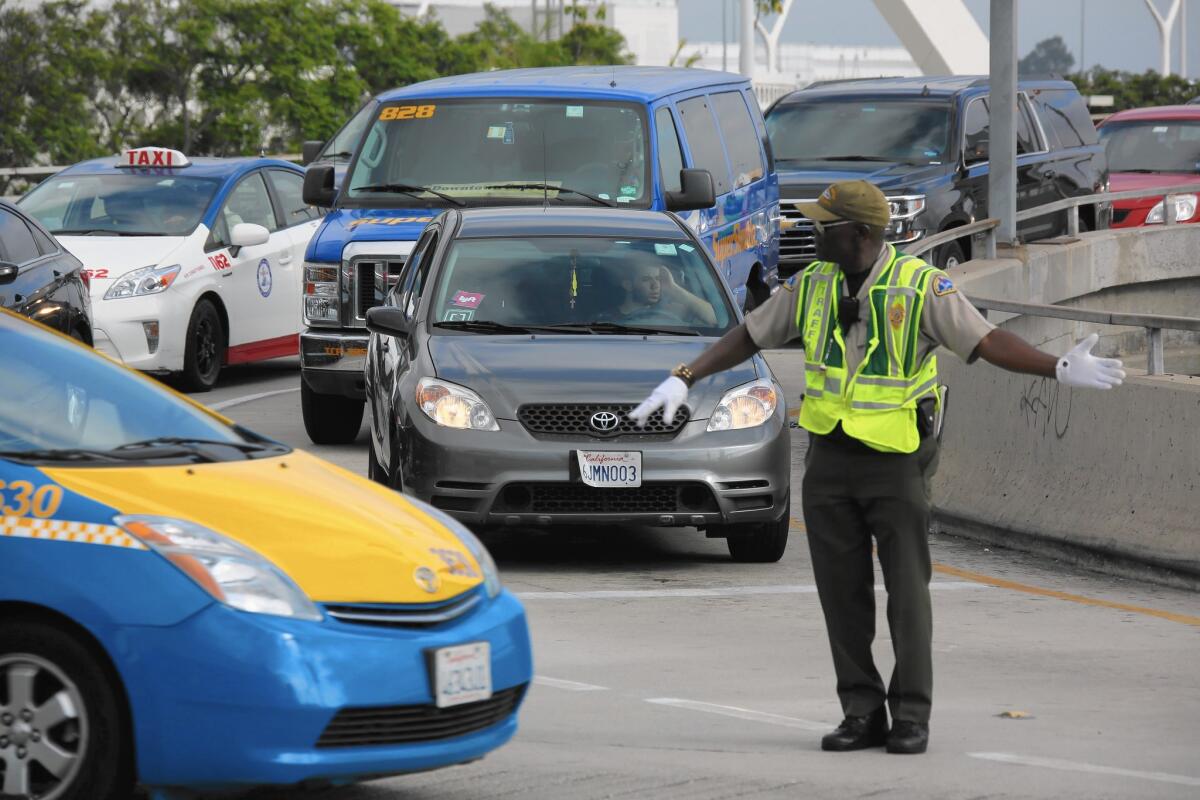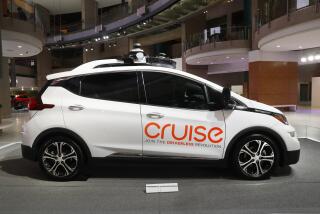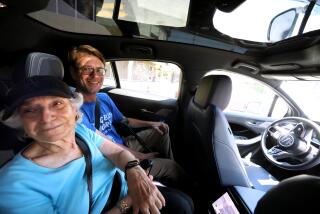Equal access at issue in PUC battle with Uber over data disclosure

A car with Uber and Lyft stickers leaves the departure terminal at Los Angeles International Airport. Uber has earned the right to legally pick up and drop off fliers from LAX, which was previously reserved for taxis.
reporting from san francisco — Uber likes to say it is the great equalizer when it comes to transportation: Anyone with a smartphone can use the app to hail a ride quickly and affordably. The state of California wants Uber to prove it, particularly the “anyone” part.
Blind people? People in wheelchairs? People who want a ride to a bad neighborhood, or out of one? By law, taxi companies are required to serve those customers and can’t pick and choose who gets rides, a practice known as redlining.
Now ride-hailing is under the same scrutiny. Uber may contend that it offers a better alternative than taxi companies, but at least where the state is concerned, they are increasingly becoming one and the same.
In June, the California Labor Commissioner’s Office decided that an Uber driver was a company employee, not a contractor. On Thursday, Uber earned the right to legally pick up and drop off fliers from LAX, which was previously reserved for taxis only.
-----
For the Record
July 17, 1:40 p.m.: An earlier version of this article incorrectly referred to the California Labor Commissioner’s Office as the California Labor Commission.
-----
And, as it does with taxi companies, the state wants to make sure all passengers are being treated equally.
The California Public Utilities Commission is demanding detailed driver data from Uber and rival ride-sharing companies — data that Uber, citing passenger privacy and proprietary business information, has so far refused to turn over. That led to a dramatic standoff Wednesday when an administrative judge for the CPUC recommended that Uber be fined $7.3 million and its operations in the state be suspended.
Uber’s rivals, Lyft and Sidecar, have complied with the regulations.
The data in question could prove or disprove discrimination, and help determine whether civil rights regulations that govern the taxi industry will also apply to ride-hailing companies.
Data such as driver hours, miles logged and training course completion are required under a 2013 CPUC ruling that allowed ride-hailing services to operate in California under state regulation.
Uber’s legal team argues some of the data that the CPUC wants is unnecessary, and constitutes trade secrets that, if revealed, could harm its business. In a filing with the agency, Uber called the demands “burdensome” and “overly broad.”
Uber is appealing the recommendation to pay a fine and to be suspended, a process that could take a few months to resolve. Uber has offered to compromise on the data release. The CPUC has, in effect, said no, the rules are clear.
Uber said it has provided most of the information demanded by the CPUC but declined to give up specific ride-by-ride details, such as where a passenger was picked up and where he or she was dropped off.
Instead, Uber is providing aggregated data along with “heat maps” to aid in data analysis. It also offered to share the detailed data with a third-party auditor.
Some neutral outsiders doubt whether the data would even be of much use in settling the redlining issue.
The agency requires ride data by ZIP Code. But, said Susan Shaheen, co-director the UC-Berkeley Transportation Sustainability Research Center, “I’m not sure ZIP Code-level data is precise enough to capture differences in socioeconomic income.”
Getting more granular, going block by block, would be more illuminating, she said. That’s the way many taxi regulators evaluate their data.
Also debatable is whether the CPUC even has the power to regulate redlining; Uber says it doesn’t. (The CPUC began as a railroad regulator and is best known as the regulator for electric utilities and phone service.) Commission President Michael Picker declined to comment.
The CPUC’s authority on regulations governing disability are more clear-cut. Besides the ZIP Code data, the judge said Uber failed to deliver required ride data for disabled passengers — including people in wheelchairs and accompanied by seeing-eye dogs — through September 2014.
In response, Uber said it added an option for disabled passengers in October 2014 and shouldn’t be penalized for failing to provide data before it added the option.
If the standoff ends in a statewide suspension, revenue and profit for San Francisco-based Uber could take a big hit.
So far, the ride-hailing industry has taken the world by storm. By exploiting inefficiencies in heavily regulated taxi markets, ride-hailing companies — Lyft and Sidecar in the United States, Didi Kuaidi in China, Ola in India, and many others — are rapidly expanding.
But none comes close to Uber, whose aggressive, even pugnacious tactics have earned it a worldwide footprint. It has drawn $5.9 billion in investment capital, translating into an implied value topping $40 billion.
As it has grown, regulators want to make sure the company is playing fair.
Transportation for the disabled is a serious issue: According to a Cornell University study, about 5% of Californians suffer a physical disability that affects their ability to move around.
To assist those customers, Uber offers UberWAV in L.A., San Francisco, San Diego and several other cities. Passengers can hire a fully wheelchair-accessible vehicle that comes with a ramp and lift capacity of 600 pounds. Critics say that with a $25 minimum fare, it’s expensive.
The company also recently launched UberAssist in Los Angeles, San Diego and Portland, where Uber drivers are trained by a third-party organization to equip them to assist the elderly. UberAssist rides cost the same as an Uber ride and can accommodate folding wheelchairs and walkers.
Greg Milk, an Uber driver in San Francisco, said he puts down his back seats to fit wheelchairs for disabled riders, and helps them into the front seat, an approach he said is encouraged by Uber.
“They tell us in the email, it’s a right, and it’s our responsibility,” he said. “We cannot reject them because of that.”
But it’s up to the drivers to comply, and there are plenty of news stories about Uber drivers refusing to allow wheelchair passengers into their cars. Some blind passengers report problems with ride-hailing services too.
Uber is battling a lawsuit filed in San Jose by the National Federation of the Blind in California, alleging many Uber drivers refuse passengers with guide dogs.
Twitter: @russ1mitchell
Twitter: @traceylien
Times staff writers Laura J. Nelson, Paresh Dave and Daina Beth Solomon contributed to this report from Los Angeles.
More to Read
Inside the business of entertainment
The Wide Shot brings you news, analysis and insights on everything from streaming wars to production — and what it all means for the future.
You may occasionally receive promotional content from the Los Angeles Times.












